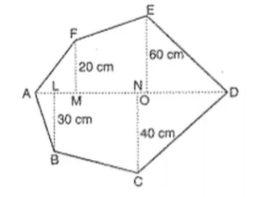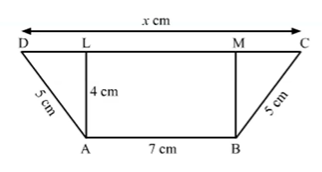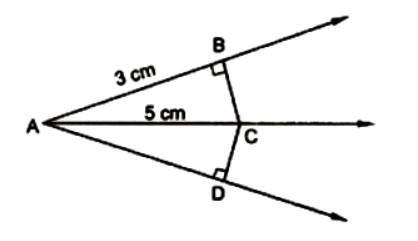Find the area of a quadrilateral ABCD in which AB=3 cm, BC=4 cm, CD=4 cm, DA=5 cm and AC=5 cm.
To find the area of quadrilateral ABCD, we can divide it into two triangles: triangle ABC and triangle ACD. We will use Heron's formula to calculate the area of each triangle.
Step 1: Calculate the area of triangle ABC
1. Identify the sides of triangle ABC:
- AB = 3 cm
- BC = 4 cm
- AC = 5 cm
2. Calculate the semi-perimeter (s) of triangle ABC:
s=AB+BC+AC2=3+4+52=122=6 cm
3. Apply Heron's formula to find the area (A) of triangle ABC:
A=√s(s−a)(s−b)(s−c)
where a=AB=3, b=BC=4, and c=AC=5.
A=√6(6−3)(6−4)(6−5)=√6×3×2×1=√36=6 cm2
Step 2: Calculate the area of triangle ACD
1. Identify the sides of triangle ACD:
- AC = 5 cm
- CD = 4 cm
- AD = 5 cm
2. Calculate the semi-perimeter (s) of triangle ACD:
s=AC+CD+AD2=5+4+52=142=7 cm
3. Apply Heron's formula to find the area (A) of triangle ACD:
A=√s(s−a)(s−b)(s−c)
where a=AC=5, b=CD=4, and c=AD=5.
A=√7(7−5)(7−4)(7−5)=√7×2×3×2=√84=2√21 cm2
Step 3: Calculate the total area of quadrilateral ABCD
1. Add the areas of triangles ABC and ACD:
Area of quadrilateral ABCD=Area of △ABC+Area of △ACD
=6+2√21 cm2
Final Answer:
The area of quadrilateral ABCD is 6+2√21 cm2.
---
- AB = 3 cm
- BC = 4 cm
- AC = 5 cm
s=AB+BC+AC2=3+4+52=122=6 cm
A=√s(s−a)(s−b)(s−c)
where a=AB=3, b=BC=4, and c=AC=5.
A=√6(6−3)(6−4)(6−5)=√6×3×2×1=√36=6 cm2
- AC = 5 cm
- CD = 4 cm
- AD = 5 cm
s=AC+CD+AD2=5+4+52=142=7 cm
A=√s(s−a)(s−b)(s−c)
where a=AC=5, b=CD=4, and c=AD=5.
A=√7(7−5)(7−4)(7−5)=√7×2×3×2=√84=2√21 cm2
Area of quadrilateral ABCD=Area of △ABC+Area of △ACD
=6+2√21 cm2
The area of quadrilateral ABCD is 6+2√21 cm2.
Topper's Solved these Questions
- HERONS FORMULABOOK - NCERTCHAPTER - HERONS FORMULAEXERCISE - Exercise 12.1
6 Videos
- HERONS FORMULABOOK - NCERTCHAPTER - HERONS FORMULAEXERCISE - Solved Examples
6 Videos
- COORDINATE GEOMETRYBOOK - NCERTCHAPTER - COORDINATE GEOMETRYEXERCISE - Exercise 3.2
2 Videos
- INTRODUCTION TO EUCLIDS GEOMETRYBOOK - NCERTCHAPTER - INTRODUCTION TO EUCLIDS GEOMETRYEXERCISE - Solved Examples
3 Videos
Similar Questions
Calculate the area of the quadrilateral ABCD as shown in Fig.33, given that BD=42 cm , AC=28 cm , OD=12 cm and AC⊥BD .
View SolutionWhich of the following pairs of triangles are congruent? If they are congruent, write out the pairs of equal angles. ABC:AB=3cm, BC=4cm, CA=2 cm DEF:DE=2 cm, EF=3 cm and FD=4 cm PQR:PQ=17 cm, QR=15 cm, PR=18 cm DEF:DE=18 cm, EF=17 cm, DF=15 cm .
View SolutionIn Figure, ABCD is a quadrilateral in which diagonal AC=84 cm ; DL⊥AC, BM⊥AC, DL=16.5 cm and BM=12 cm . Find the area of quadrilateral ABCD.
View SolutionFind the area of the following polygon, if AL=10cm, AM=20cm, AN=50cm, AO=60cm and AD=90cm.

View SolutionIn Fig. 10.57, a circle is inscribed in a quadrilateral ABCD in which ∠B=90o . If AD=23cm , AB=29cm and DS=5cm , find the radius r of the circle. (FIGURE)
View SolutionIn Figure, ABCD is a trapezium in which AB=7cm, AD=BC=5cm, DC=x cm, and distance between AB and DC is 4cm . Find the value of x and area of trapezium ABCD

View SolutionIn fig. 15 ABCD is a parallelogram CM⊥AB and BL⊥AD. If AB=16 cm, AD=12 cm, CM=10 cm, find BL If AD=10cm, CM=8cm, BL=12 cm, find AB .
View SolutionIn Figure, if AC is bisector fo ∠BAD such that AB=3 cm and AC=5 cm, then CD= 2 cm (b) 3 cm (c) 4 cm (d) 5 cm

View SolutionIn a ABC, D and E are points on the sides AB and AC respectively. For each of the following cases show that DEBC : AB=10.8cm, BD=4.5 cm, AC=4.8cm and AE=2.8cm (ii) AD=5.7cm, BD=9.5cm, AE=3.3cm and EC=5.5cm .
View SolutionIn a ABC, D and E are points on the sides AB and AC respectively. For each of the following cases show that DEBC : AB=12 cm, AD=8 cm, AE=12 cm and AC=18 cm . (ii) AB=5.6 cm, AD=1.4 cm, AC=7.2 cm and AE=1.8 cm
View Solution
